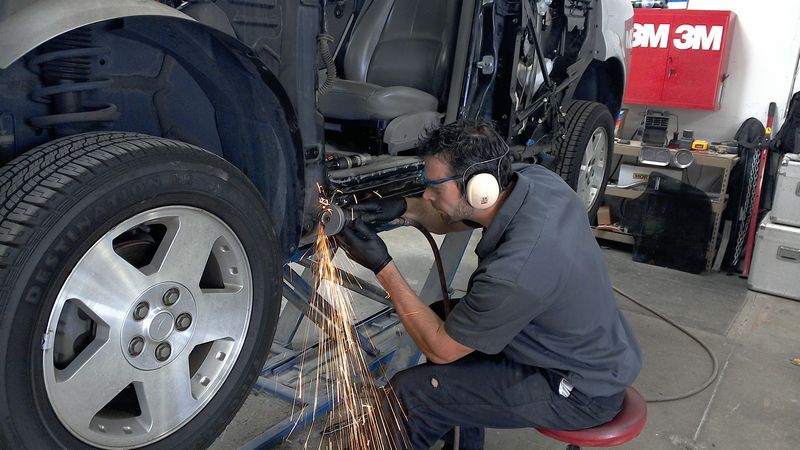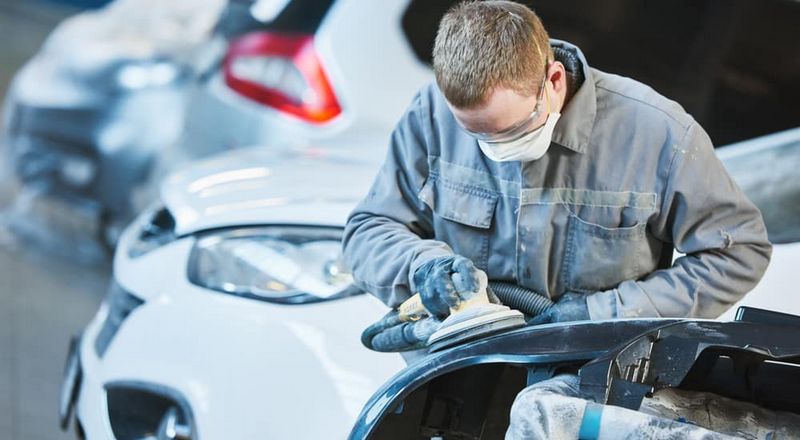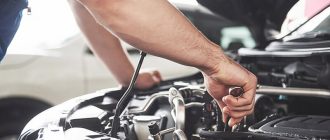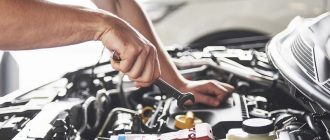
The Environmental Impact of Auto Body Repair
Auto body repair has become an integral part of the automotive industry, with millions of vehicles needing repairs every year. While this service plays a crucial role in keeping vehicles on the road, it also has a significant environmental impact.
The environmental impact of auto body repair stems from various factors, including the use of harmful chemicals, energy consumption, and waste generation. The repair process often involves the use of solvents, paints, and other chemicals that can be harmful to both human health and the environment. These substances can contaminate the air, water, and soil if not handled and disposed of properly.
In addition to the use of chemicals, auto body repair shops also consume a significant amount of energy. From powering tools and equipment to maintaining suitable working conditions, energy consumption can contribute to greenhouse gas emissions and energy waste. Finding sustainable solutions to reduce energy consumption and promote efficiency is crucial for minimizing the environmental impact.
Furthermore, the auto body repair industry generates a substantial amount of waste, including damaged parts, packaging materials, and old car components. The disposal of this waste can be problematic if not managed responsibly. Implementing recycling programs and adopting eco-friendly practices are essential steps towards reducing waste generation and promoting a circular economy.
As the automotive industry continues to grow, addressing the environmental impact of auto body repair becomes increasingly critical. By adopting sustainable solutions, such as using environmentally friendly alternatives to harmful chemicals, optimizing energy consumption, and implementing waste reduction strategies, the industry can minimize its environmental footprint and contribute to a greener future.
The Impact of Auto Body Repair on the Environment
Auto body repair has a significant environmental impact due to the materials and processes involved. The body repair industry often relies on harmful chemicals, generates hazardous waste, and consumes non-renewable resources. These factors contribute to pollution, resource depletion, and climate change.
The use of materials such as paints, solvents, and adhesives contain volatile organic compounds (VOCs), which can contribute to air pollution and pose health risks to workers and nearby communities. VOCs can be released during painting and refinishing processes, contributing to the formation of ground-level ozone and smog.
In addition to air pollution, the auto body repair process generates a significant amount of hazardous waste, such as used paint thinners, solvents, and other potentially toxic materials. Improper disposal of these wastes can contaminate soil and water sources, posing a risk to ecosystems and human health.
The repair industry also consumes a large amount of non-renewable resources, including energy and raw materials. Manufacturing new body parts and using energy-intensive processes, such as welding and sanding, contribute to carbon emissions and resource depletion.
To address these environmental impacts, the auto body repair industry needs to adopt sustainable solutions. This includes the use of eco-friendly materials and practices that minimize the release of VOCs and reduce waste generation. Recycling and reusing materials whenever possible can also help reduce resource consumption and waste disposal.
Additionally, promoting alternative repair methods, such as paintless dent removal and repairing rather than replacing damaged parts, can significantly reduce the environmental impact of auto body repair. Implementing effective waste management and disposal practices, including proper handling and recycling of hazardous materials, is also crucial.
By prioritizing sustainability in auto body repair, we can minimize the environmental impact of the industry and contribute to a cleaner and healthier environment for present and future generations.
Sustainable Solutions and Environmental Awareness
As we become more aware of the impact that auto body repair can have on the environment, it is crucial to find sustainable solutions that minimize the negative effects. The repair of auto bodies often involves the use of chemicals and materials that can be harmful to both human health and the environment.
One sustainable solution is to promote the use of eco-friendly products and practices in auto body repair. This includes using water-based paints and coatings instead of solvent-based ones, which release volatile organic compounds (VOCs) into the atmosphere. Water-based paints are not only safer for the environment and the workers, but they also produce a better finish with less waste.
Another area where sustainable solutions can be implemented is in waste management. Auto body repair shops generate a significant amount of waste, including paint sludge, scrap metal, and plastic. It is important for these shops to have proper recycling and disposal systems in place to minimize the environmental impact of these waste materials.
- Implementing a recycling program for metal and plastic waste
- Investing in equipment that allows for better paint and solvent waste management
- Promoting the use of reusable materials and parts whenever possible
- Encouraging customers to choose repair over replacement, reducing the demand for new auto parts
Additionally, raising awareness about the environmental impact of auto body repair is essential. By educating the public about the importance of sustainable solutions, we can encourage more people to support auto body shops that prioritize environmental responsibility. This can be done through informational campaigns, workshops, and collaborations with schools and community organizations.
In conclusion, sustainable solutions in auto body repair are crucial for mitigating the environmental impact of this industry. By promoting the use of eco-friendly products, implementing proper waste management systems, and raising awareness among the general public, we can work towards a more sustainable future for the auto repair industry.
Reducing Carbon Emissions Through Efficient Repairs
Repairing auto body damage is not only essential for maintaining the appearance and functionality of vehicles, but it also plays a crucial role in minimizing the environmental impact of the automotive industry.
When cars are involved in accidents or sustain damage, the conventional practice is to replace damaged parts with new ones, which requires additional production and increases carbon emissions. However, by employing efficient repair techniques, such as paintless dent repair and spot repairs, auto body shops can significantly reduce the carbon footprint associated with repairs.
Paintless dent repair is a technique that involves removing dents and dings from the vehicle’s body without the need for painting. This method not only saves time and money but also eliminates the carbon emissions generated during the painting process. By utilizing specialized tools and techniques, trained technicians can massage the damaged area from behind the panel, restoring it to its original shape. This reduces the need for filler materials and paint, ultimately minimizing the environmental impact.
In addition to paintless dent repair, spot repairs offer another sustainable solution for the automotive industry. Instead of repainting an entire panel, spot repairs focus on repairing only the damaged area. This reduces the amount of paint, solvent, and energy required, leading to a decrease in carbon emissions. Spot repairs are particularly effective for minor scratches, chips, or localized damage, allowing technicians to seamlessly blend the repaired area with the rest of the vehicle’s paintwork.
Furthermore, efficient repairs also extend the lifespan of vehicles, reducing the need for premature replacements. This, in turn, helps minimize the environmental impact associated with manufacturing new cars and disposing of old ones. By promoting the use of efficient repair practices, auto body shops can contribute to sustainable solutions that benefit both the industry and the environment.
- Paintless dent repair and spot repairs are sustainable alternatives to traditional auto body repair methods.
- These techniques minimize the need for new parts and reduce carbon emissions associated with production.
- Efficient repairs extend the lifespan of vehicles, reducing the need for premature replacements.
- By utilizing efficient repair practices, the automotive industry can contribute to environmental sustainability.
Recycling and Reusing Materials in Auto Body Repair
When it comes to auto body repair, the environmental impact can be significant. The process of repairing damaged vehicle bodies often requires the use of new materials, which can contribute to waste and pollution. However, there are sustainable solutions that can help minimize this environmental impact.
One such solution is recycling and reusing materials in auto body repair. By recycling materials, such as metal, plastic, and glass, we can reduce the need for new resources and conserve energy. Additionally, reusing materials, such as parts from old vehicles, can further reduce waste and minimize the overall environmental impact of the repair process.
Recycling materials in auto body repair can be done through various processes. For example, metals such as aluminum and steel can be melted down and repurposed for use in new auto parts. Plastic materials can be shredded and transformed into pellets, which can then be used in the manufacturing of new plastic parts. Glass materials can also be recycled and melted down to create new glass products.
Reusing materials in auto body repair involves salvaging and refurbishing parts from old vehicles. This can include components such as doors, fenders, and bumpers, which can be reused in the repair of other vehicles. By reusing these parts, we can reduce the demand for new materials and prevent them from ending up in landfills.
| – Reduces waste and landfill usage |
| – Conserves natural resources |
| – Minimizes energy consumption |
| – Helps prevent pollution from manufacturing new materials |
| – Supports a circular economy |
In conclusion, recycling and reusing materials in auto body repair can have significant environmental benefits. By implementing sustainable practices, such as recycling metals and plastics, and reusing components from old vehicles, we can reduce waste, conserve resources, and minimize the overall environmental impact of the auto body repair industry.

Minimizing Waste and Landfill Pollution
One of the major environmental impacts of the auto body repair industry is the generation of waste and landfill pollution. The production of new auto parts and the disposal of old parts contribute to the problem of excessive waste. However, there are several strategies that can be implemented to minimize waste and reduce landfill pollution in the auto body repair process.
- Recycling: Implementing a recycling program in auto body repair shops can significantly reduce waste and landfill pollution. This involves separating materials such as metal, plastic, and glass for recycling, rather than sending them to the landfill.
- Reuse: Another approach to minimize waste is to promote the reuse of parts whenever possible. Repair shops can inspect and repair damaged parts rather than automatically replacing them with new ones. This not only reduces waste but also saves on the energy and resources required to manufacture new parts.
- Proper disposal: When parts cannot be reused or recycled, it is important to ensure they are disposed of properly. Auto body repair shops should follow local regulations and guidelines for disposing of hazardous materials such as chemicals, paints, and solvents. By doing so, the risk of contaminating landfills and groundwater is minimized.
- Inventory management: Effective inventory management can help reduce waste in the auto body repair process. By accurately forecasting the demand for auto parts and optimizing stock levels, repair shops can minimize excess inventory and avoid unnecessary waste.
- Education and training: Educating and training auto body repair technicians about sustainable practices can play a crucial role in minimizing waste and landfill pollution. By providing information and resources on environmentally-friendly repair techniques and materials, technicians can make informed decisions that reduce their impact on the environment.
By implementing these strategies, the auto body repair industry can make significant progress in minimizing waste and reducing landfill pollution. This not only benefits the environment but also contributes to a more sustainable and responsible auto repair industry.
Promoting Eco-Friendly Paints and Coatings
One of the key ways to reduce the environmental impact of auto body repair is by promoting the use of eco-friendly paints and coatings. Traditional paints and coatings often contain harmful chemicals and solvents that can have detrimental effects on the environment.
By encouraging the use of environmentally friendly alternatives, such as water-based paints and low-VOC (volatile organic compounds) coatings, we can significantly decrease the negative impact on our surroundings. These eco-friendly options emit fewer harmful pollutants into the air, reducing the risk of air pollution and its associated health risks.
Not only are eco-friendly paints and coatings better for the environment, but they also offer several advantages in terms of durability and quality. Water-based paints and low-VOC coatings have improved in recent years and can now provide excellent adhesion, coverage, and color matching capabilities. They also have a faster drying time, reducing the overall repair time for auto bodies.
Additionally, by using eco-friendly paints and coatings, we can minimize the use of hazardous materials and the need for specialized equipment, such as spray booths, that are required for the application of traditional paints. This reduces the energy consumption and waste associated with the auto body repair process.
Furthermore, promoting the use of eco-friendly paints and coatings can help raise awareness among consumers about the importance of sustainable practices in the auto body repair industry. By demonstrating the benefits of these environmentally friendly options, we can encourage more people to choose repair shops that prioritize sustainability, leading to a positive impact on the environment.
In conclusion, promoting the use of eco-friendly paints and coatings in auto body repair is a crucial step towards reducing the environmental impact of this industry. By utilizing water-based paints and low-VOC coatings, we can minimize the release of harmful chemicals and pollutants into the air, improve the quality and efficiency of repairs, and raise awareness about sustainable practices in the industry.
Importance of Proper Disposal of Hazardous Materials
The body repair industry has a significant impact on the environment due to the hazardous materials used in the repair process. These materials can include paints, solvents, cleaning agents, and adhesives, among others. Improper disposal of these hazardous materials can lead to the contamination of soil, water sources, and air, posing a threat to human health and the ecosystem.
Proper disposal of hazardous materials is crucial to minimize the potential environmental harm. Auto body repair shops must adhere to regulations and guidelines set by environmental agencies to ensure the safe handling and disposal of these materials. This includes using approved containers for storage, labeling containers appropriately, and arranging for licensed waste disposal services.
By disposing of hazardous materials correctly, the risk of leaks, spills, and accidents is reduced. It also helps prevent the release of harmful chemicals into the environment, which can have long-lasting effects on ecosystems and human health. Additionally, proper disposal practices contribute to the conservation of natural resources by preventing the contamination of water sources and reducing the need for remediation activities.
The importance of proper disposal of hazardous materials extends beyond environmental concerns. It also promotes a safer working environment for auto body repair technicians and personnel, as well as the surrounding community. By incorporating sustainable practices into the repair process, auto body shops can contribute to a greener, healthier future for both people and the planet.
Adopting Green Technologies in Auto Body Repair
The impact of auto body repair on the environment is a growing concern. With the increasing number of vehicles on the road, the need for auto body repair is also rising. However, traditional auto body repair methods often contribute to pollution and waste. That is why it is important for the industry to adopt green technologies and practices.
One way to reduce the environmental impact of auto body repair is by using water-based paints and coatings. Traditional solvent-based paints contain harmful chemicals that can pollute the air and water. Water-based paints, on the other hand, have lower VOC emissions and are easier to clean up. By switching to water-based paints, auto body repair shops can significantly reduce their carbon footprint.
Another green technology that can be adopted is the use of energy-efficient equipment. Auto body repair shops often rely on power-hungry tools and machinery. By investing in energy-efficient equipment, such as LED lighting and high-efficiency compressors, shops can reduce their energy consumption and lower their operating costs. This not only benefits the environment but also provides long-term cost savings.
Additionally, auto body repair shops can implement recycling programs to reduce waste. Many materials used in the repair process, such as metal, glass, and plastic, can be recycled. By separating and recycling these materials, shops can minimize the amount of waste sent to landfills and contribute to a more sustainable future.
Furthermore, it is important for auto body repair shops to properly dispose of hazardous materials. Chemicals and fluids used in the repair process, such as paint thinners and oil, can be harmful to the environment if not handled correctly. By following proper disposal procedures and using eco-friendly alternatives when possible, shops can prevent these hazardous substances from contaminating the soil and water.
In conclusion, adopting green technologies in auto body repair is crucial for reducing the industry’s environmental impact. By using water-based paints, investing in energy-efficient equipment, implementing recycling programs, and properly disposing of hazardous materials, auto body repair shops can contribute to a more sustainable future.
Advantages of Using Energy-Efficient Equipment
When it comes to auto body repair, using energy-efficient equipment can have several advantages for the environment. By incorporating energy-efficient practices into the repair process, both the environmental impact and the carbon footprint of auto body repair can be reduced.
1. Reduced Energy Consumption: Energy-efficient equipment is designed to consume less energy while still delivering the same level of performance. By using such equipment in auto body repair, the energy consumption can be significantly reduced, leading to lower electricity bills and decreased strain on power grids. This not only helps to conserve valuable energy resources but also reduces the carbon emissions associated with electricity generation.
2. Lower Emissions: Energy-efficient equipment is often designed to emit fewer greenhouse gases and other pollutants compared to traditional equipment. By using energy-efficient tools and machinery in auto body repair, the emission of harmful substances can be minimized. This helps to improve the air quality in the surrounding environment and reduces the overall environmental impact of the repair process.
3. Enhanced Durability: Energy-efficient equipment is typically designed to be more durable and long-lasting. This means that less frequent replacements and repairs are needed, leading to reduced waste and resource consumption. By investing in energy-efficient tools and machinery for auto body repair, businesses can save money in the long run and contribute to a more sustainable future.
4. Compliance with Regulations: Many countries and regions have implemented regulations to reduce the environmental impact of various industries, including auto body repair. By using energy-efficient equipment, businesses can ensure compliance with these regulations and avoid potential fines or penalties. Additionally, demonstrating a commitment to environmentally friendly practices can enhance a company’s reputation and attract environmentally conscious customers.
5. Cost Savings: In addition to the environmental benefits, using energy-efficient equipment in auto body repair can also lead to cost savings. Lower energy consumption means lower electricity bills, and the decreased need for replacements and repairs can result in significant cost savings over time. By investing in energy-efficient equipment, businesses can not only reduce their environmental impact but also improve their bottom line.
In conclusion, using energy-efficient equipment in auto body repair can bring numerous advantages. From reducing energy consumption and emissions to improving durability and compliance with regulations, businesses can contribute to a more sustainable future while also enjoying cost savings. Embracing energy-efficient practices in the auto body repair industry is a win-win solution for both the environment and the business.
Benefits of Eco-Friendly Auto Body Repair Shops
Eco-friendly auto body repair shops offer numerous benefits in terms of reducing the environmental impact of the automotive industry. These shops employ sustainable practices in order to minimize their body repair processes’ negative effects on the environment.
One of the main benefits of eco-friendly auto body repair shops is their reduced impact on the environment. Traditional auto body shops often use harmful chemicals, such as solvents and paints, that can release harmful pollutants into the air and water. In contrast, eco-friendly shops use eco-friendly products and materials that are less harmful to the environment.
Another benefit is the use of energy-efficient technologies and practices. Eco-friendly auto body repair shops aim to reduce their energy consumption by using energy-efficient lighting, equipment, and vehicles. By doing so, these shops contribute to the overall reduction of greenhouse gas emissions and help mitigate climate change.
Eco-friendly auto body repair shops also prioritize recycling and waste management. They make efforts to recycle materials like metal, plastic, and glass that are commonly found in auto body repair processes. This reduces the amount of waste that goes to landfills and further contributes to the conservation of natural resources.
Moreover, these shops often promote sustainable transportation options. They may offer shuttle services, encourage carpooling, or have partnerships with local sustainable transportation providers. By doing so, eco-friendly auto body repair shops support the use of environmentally friendly modes of transportation and contribute to reduced air pollution.
In conclusion, eco-friendly auto body repair shops provide numerous benefits for the environment and society as a whole. By employing sustainable practices, these shops reduce their negative impact on the environment, contribute to energy efficiency, promote recycling and waste management, and support sustainable transportation options. Making the switch to eco-friendly auto body repair shops is not only beneficial for the environment but also for individuals who prioritize sustainability.
Questions and answers:
What are the major environmental impacts of auto body repair?
The major environmental impacts of auto body repair include the generation of hazardous waste, the emission of volatile organic compounds (VOCs), and the consumption of energy and natural resources.
How does the generation of hazardous waste affect the environment?
The generation of hazardous waste from auto body repair can contaminate soil and water systems, posing a risk to human health and ecosystems. Proper disposal of hazardous waste is crucial to prevent pollution.
What are volatile organic compounds (VOCs) and why are they a concern?
Volatile organic compounds (VOCs) are organic chemicals that easily vaporize at room temperature. They can contribute to the formation of air pollution and smog, as well as have harmful health effects. In auto body repair, VOCs are emitted from paints, solvents, and cleaning agents.
How is energy consumption involved in auto body repair?
Auto body repair shops require energy for their operations, including electricity for lighting and equipment, as well as heating or cooling systems. The production of materials used in repairs, such as metals and plastics, also requires significant energy.
What are some sustainable solutions for reducing the environmental impact of auto body repair?
Some sustainable solutions for reducing the environmental impact of auto body repair include using water-based paints and low-VOC or toxic-free solvents, implementing proper waste management and recycling practices, and adopting energy-efficient technologies and practices.
What are some of the environmental impacts of auto body repair?
Auto body repair can have several environmental impacts, including the release of harmful chemicals into the air and water, the generation of hazardous waste, and the consumption of energy and resources.
How can auto body repair shops address these environmental impacts?
Auto body repair shops can address these environmental impacts by implementing sustainable solutions. This can include using eco-friendly products and techniques, properly disposing of hazardous waste, reducing energy and water consumption, and recycling materials whenever possible.





